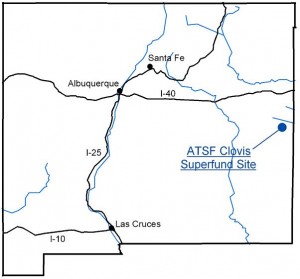Site History:
Beginning in the early 1900’s, wastewater from the ATSF Site containing heavy metals, total petroleum hydrocarbons and cyanide was discharged into Santa Fe Lake.
Location:
The Atchison Topeka and Santa Fe (ATSF) Clovis Site is located approximately one mile south of the ATSF Railway switching yard in Clovis, New Mexico.
Trustees:
State of New Mexico
United States Fish and Wildlife Service
Overview:
The Office of Natural Resources Trustee (ONRT), together with co-Trustee U.S. Department of the Interior Fish and Wildlife Service, entered into a settlement with the Burlington Northern and Santa Fe Railway Company for $489,000 for natural resource damages at the Atchison Topeka and Santa Fe Clovis Site. Of the settlement funds, $459,000 was for the restoration of injuries to birds, wildlife, and their supporting habitat caused by releases of hazardous substances into the Santa Fe Playa Lake in Clovis, NM, and $59,750 was for the reimbursement of outstanding damage assessment costs. The consent decree for the settlement was approved by the U.S. District Court on January 14, 2004.
Restoration Activities:
A draft restoration plan/environmental assessment was issued in October 2006. In response to public comments, a revised draft restoration plan/environmental assessment was prepared in which additional restoration projects were considered.
The Final Natural Resources Restoration Plan and Environmental Assessment for the AT&SF (Clovis) New Mexico Superfund Site dated April 2007, identifies the Curry County Playa Conservation Project as the selected restoration project.
Curry County Playa Conservation Project
This project focused on the protection and restoration of playas within Curry County. The primary objective of the project was to preserve beneficial playa habitat through 11.5-year conservation agreements with landowners. Healthy playas are considered keystone ecosystems that serve as critical sites of biodiversity in an area otherwise characterized by semi-arid rangeland and intensive agriculture. The playas also play a very valuable role as groundwater recharge areas to the Ogallala aquifer, the largest and most important aquifer in the High Plains. Project restoration activities included limiting grazing, brush management, range planting, and earthwork. Ten playas, amounting to approximately 975 acres of playa lakes and immediately adjacent uplands, were enrolled for conservation from November 2007 through December 2018. The ONRT and the U.S. Fish and Wildlife Service oversaw the restoration activities implemented by the Central Curry Soil and Water Conservation District to ensure the success of this playa protection and conservation project.

